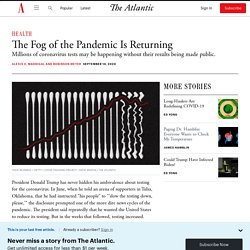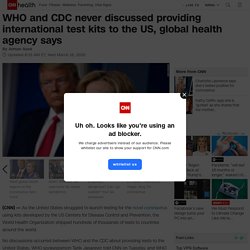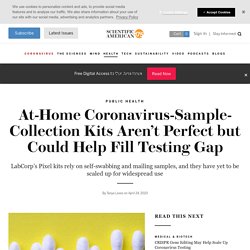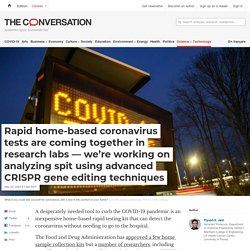

How Jared Kushner’s Secret Testing Plan “Went Poof Into Thin Air” And that is where the U.S. finds itself today—in a massive testing crisis.

States have been forced to go their own way, amid rising case counts, skyrocketing demand for tests, and dwindling laboratory capacity. By mid-July, Quest Diagnostics announced that the average time to turn around test results was seven days. It is obvious to experts that 50 individual states cannot effectively deploy testing resources amid vast regulatory, financial, and supply-chain obstacles. The diagnostic-testing industry is a “loosely constructed web,” said Dr. Pellini of Section 32, “and COVID-19 is a stage five hurricane.” Dr. Experts are now warning that the U.S. testing system is on the brink of collapse. In late January, Rajiv Shah, president of the Rockefeller Foundation, went to Davos, Switzerland, and served on a panel at the World Economic Forum with climate activist Greta Thunberg. Meanwhile, he kept watching and waiting for what he assumed would be a massive federal mobilization.
How Many People Is America Testing for the Coronavirus? Atlas, who has no background in infectious disease, has advocated for a so-called herd-immunity approach, asserting that the federal government should protect only the elderly and the most vulnerable from COVID-19.

This would lead to many more American deaths—Sweden, which pursued a similar policy, has a higher case-fatality rate than the United States, the European Union average, Iran, and more than 100 other countries, according to data from Johns Hopkins University—and it may not even work. How Does Testing in the U.S. Compare to Other Countries? - (updating) JHCRC. Global COVID-19 Testing (3/9 - 4/29) Coronavirus VI - Testing: LWT w/ John Oliver 5/3/20. How Does Antibody Testing Work? We Went Behind the Scenes to Find Out.
5/1/20: Dogs are being trained to sniff out COVID-19 in humans. Scientists are training dogs to identify COVID-19 by following their noses.

A new program at the University of Pennsylvania's School of Veterinary Medicine (Penn Vet) is putting noses to the grindstone for disease detection. Researchers are working with dogs to see if the canines' superior sniffers can help with early detection of COVID-19 in humans. Dogs that can pinpoint the scent of COVID-19 could identify infection in people who are asymptomatic, and could play a valuable role in disease response as people return to work and social-distancing restrictions are relaxed, Penn Vet representatives said in a statement. Related: Coronavirus outbreak: Live updates Reports of dogs sniffing out cancer have been documented since the 1980s, Live Science previously reported. In the Penn Vet program, eight dogs will initially be trained in a laboratory setting.
4/20/20: Coronavirus tests: what they are and how they can help. 4/16/20: Anyone With Coronavirus Symptoms in Illinois Can Now Get Tested. CHICAGO — Anyone with coronavirus symptoms can now get tested in Illinois, Gov.

JB Pritzker announced Thursday, an important expansion of the testing officials hope will be a key path out of the crisis. Previously, officials encouraged people with mild symptoms to stay home and recover in self-isolation to preserve the low supply of tests. But as the state ramps up testing sites and acquires more supplies, officials are telling people with symptoms they can now be tested even without a doctor’s order. 4/5/20: No COVID-19 testing at home yet but quicker options coming. WASHINGTON (AP) — Home testing for the new coronavirus may sound like a good idea, but U.S. regulators say it’s still too risky.

They’ve stopped companies that quickly launched home-testing kits until they can show their products can accurately detect the virus. For now, the only way Americans can get tested is at hospitals, clinics or drive-thru sites, with a doctor’s order. After a botched rollout, testing in the U.S. has ramped up thanks to high-volume testing machines and new rapid tests. Last week, federal officials said total tests topped 1.4 million, and labs are processing nearly 100,000 tests daily. That’s the threshold many experts say is needed to track the virus. Still, testing continues to be constrained by shortages of medical supplies like gloves, masks and swabs.
Meanwhile, the Food and Drug Administration is aggressively pushing new options onto the market. 3/18/20: CDC chose not to accept early delivery of WHO COVID-19 test kits. No discussions occurred between WHO and the CDC about providing tests to the United States, WHO spokesperson Tarik Jasarevic told CNN on Tuesday, and WHO did not offer coronavirus tests to the CDC.

The United States, Jasarevic confirmed, doesn't ordinarily rely on WHO for tests because the US typically has the capacity to manufacture its own diagnostics. On January 17, WHO published a protocol from German researchers with the instructions necessary for any country to manufacture coronavirus tests. That same day, a top US health official said that the CDC had developed an early version of its own test -- not relying on any protocols published by the WHO. "We actually do have laboratory diagnostics here at CDC that are stood up," said Dr. Nancy Messonnier, director of the National Center for Immunization and Respiratory Diseases. Testing began at the CDC, and on February 5, the agency announced it would begin shipping test kits to public health labs around the country.
At-home Covid-19-sample-collection kits not perfect but could help fill testing gap. The U.S.

Food and Drug Administration authorized the first at-home collection kits for novel coronavirus testing this week. The kits, made by the Burlington, N. C. –based company LabCorp, allow patients to swab their own nasal passages and mail the samples back to one of the company’s laboratories for analysis—without setting foot in a hospital or clinic. The method’s risk of false negative results, as well as its cost and limited availability, may hinder its widespread use. The home-collection kit, called Pixel by LabCorp, will initially be available only to health care workers and first responders who have possibly been exposed to the virus.
Unlike the notoriously long nasopharyngeal swabs that trained health care workers insert deep into people’s nasal passage in most current COVID-19 tests, the home kit utilizes a shorter, Q-tip–like swab. Coronavirus: how to self-swab. Coronavirus self-test swab technique. Rapid home-based coronavirus tests coming together in research labs — analyzing spit using advanced CRISPR gene editing techniques. A desperately needed tool to curb the COVID-19 pandemic is an inexpensive home-based rapid testing kit that can detect the coronavirus without needing to go to the hospital.

The Food and Drug Administration has approved a few home sample collection kits but a number of researchers, including myself, are using the gene-editing technique known as CRISPR to make home tests. If they work, these tests could be very accurate and give people an answer in about an hour. I am a biomolecular scientist with training in pharmaceutical sciences and biomedical engineering and my lab focuses on developing next-generation of technologies for detecting and treating cancer, genetic and infectious diseases.
The COVID-19 disease is caused by a coronavirus named severe acute respiratory syndrome coronavirus 2 (SARS-CoV-2). Unlike humans which carry their genetic material encoded in DNA, the coronavirus encodes theirs in a related molecule called RNA. How to Make At-Home Coronavirus Testing Work. Executive Summary A number of organizations are ready to roll out services for at-home testing for Covid-19.

They could play an important role in containing the spread of the pandemic, but for these services to work, they must take into account human behavior. This article offers suggestions, which draw from design thinking. One of the most critical elements to reducing the spread of the novel coronavirus, Covid-19, and providing health care to those who suffer complications is our ability to rapidly and safely test large numbers of people for the virus. At-home testing, which several organizations hope to soon introduce once guidance from the U.S. The test that’s currently being performed in hospitals and clinics employs a polymerase chain reaction (PCR) molecular technique and involves a nasal swab usually administered by a trained care professional. Here is how home testing would work. The novelty of the solution is its simplicity.